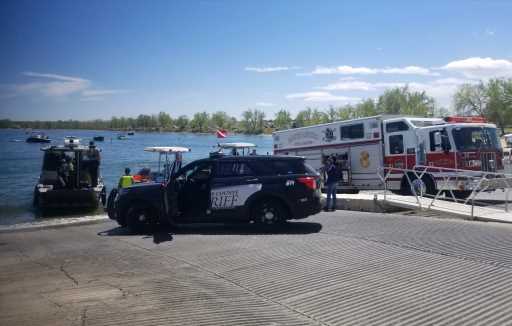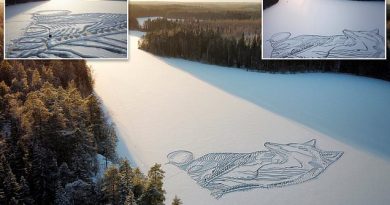Colorado officials urge safe water recreation following rash of drownings
Four people died in suspected drownings along Colorado’s Front Range this week, leading state officials to urge residents and visitors alike to be safe as water-based recreation ramps up for the summer.
A man’s body was pulled from Chatfield Reservoir on Sunday, two people died in separate incidents Monday on the Arkansas River, and the body of a missing swimmer was found in 25 feet of water at Lake Pueblo State Park on Tuesday evening.
Such tragedies are not atypical in Colorado. In 2020, the state experienced a record high for drowning-related deaths with 34 fatalities, according to Colorado Parks and Wildlife. There were 22 drowning deaths in the state last year.
“This year, we’ve already recorded 12 deaths from drowning in Colorado,” said Bridget Kochel , a spokeswoman for Colorado Parks and Wildlife. “Every year we really try to educate residents about how important it is to wear life jackets and recreate on the water responsibly. We want people to enjoy the outdoors, but it’s very important that they take caution while they’re on Colorado waters.”
The latest suspected drownings come after two similar deaths last month.
A man’s body was recovered May 14 at the bottom of Cherry Creek Reservoir, a week after he went under and did not reemerge from the water while tubing. And a boat capsized May 30 due to high winds in Lake Pueblo State Park, leaving one dead.
On Sunday, a man died after going under a buoy in Chatfield Reservoir, according to the Jefferson County Sheriff’s Office. The Jefferson County coroner is conducting an autopsy to determine the official cause of death, which is believed to be a drowning.
And on Monday, a flipped boat in the Royal Gorge, west of Cañon City, leaving one man dead, while a swimmer is believed to have drowned in Lake Pueblo later that same day. Both events remain under investigation.
The death in the Royal Gorge happened after a private boat with three passengers onboard flipped in the Sunshine Rapid. The individual who died in the accident tried to swim through a rapid commonly known as Sledge Hammer, according to Colorado Parks and Wildlife.
The person was found further downstream, and commercial rafting guides began performing CPR. In spite of these efforts, the individual was pronounced dead before Colorado Parks and Wildlife Rangers arrived on scene, officials said.
The Fremont County coroner will determine the cause of death.
Later in the day Monday, a swimmer went missing from a group in Fish Hook Cove at Lake Pueblo State Wildlife Area, state officials said.
An hour after park rangers were contacted for help, a body was found with the assistance of an underwater drone known as a Remote Operated Vehicle, Colorado Parks and Wildlife said.
The body was then turned over to the Pueblo County Coroner’s Office for identification and a determination of the cause of death.
Tuesday evening, Colorado Parks and Wildlife announced the body of swimmer who’d gone missing had been located. Witnesses told state parks rangers that a man who’d been about 300 feet offshore in an inflatable device jumped off fearing his daughter was distressed — then disappeared into the water.
Though the cause of death has not yet been determined in the most recent incidents, most of Colorado’s boat-related deaths are a result of drowning, state officials said.
“The majority of flatwater drownings could have been prevented if the victims were wearing life jackets,” said Grant Brown, boating safety and registration program manager at Colorado Parks and Wildlife . “Once victims enter our cold waters, they have minutes before they start suffering from the effects of hypothermia since they generally don’t have appropriate thermal protection. They have a short period of time before they start to lose dexterity in their fingers. Cold water also leads to cramping which can make it virtually impossible to swim.”
As temperatures get warmer this time of year, the appeal of outdoor activities, especially water-related activities, increases. Despite the hot temperatures, water conditions can still be very cold, meaning that hypothermia remains a threat, even in Colorado’s summer months.
Kochel said that wearing a lifejacket, taking safety courses for those inexperienced with boating, paddling or kayaking, as well as carrying all the required safety gear (flags, whistles and the aforementioned lifejacket), are good preventative means to avoid accidents on the water.
In addition, being aware of weather and water conditions and making sure one’s boat is in good condition prior to taking it out reduces the risk of accidents.
“We always encourage people to know before they go. Be mindful of the weather. If on a small craft like a paddle board, canoe or kayak, we recommend heading to shore and waiting out wind events,” Brown said.
Sobriety while boating is very important as well, as alcohol, Kochel said, tends to be one of the leading contributing factors in many boating-related deaths.
Colorado Parks and Wildlife says that there aren’t any lakes in the state that are necessarily deadlier than others. Rather, the weather and water conditions tend to be what increase the risk of boating.
It’s advised that people refrain from boating alone. If they do choose to venture onto the water by themselves, Brown recommends that “you tell someone where you’re going and when you expect to be home.”
“We don’t want people to be scared of the water. We want people to have fun. Our state has so much beauty where you can enjoy the water. We just need to stress how important it is to be safe,” Kochel said.
Source: Read Full Article



